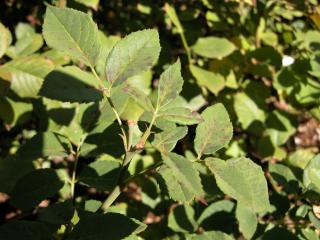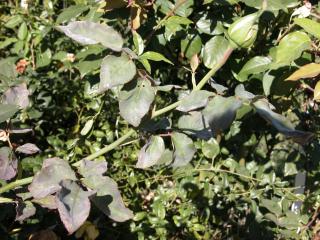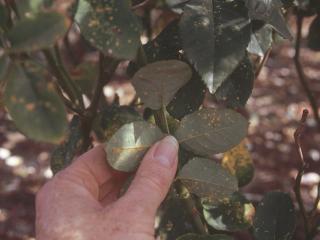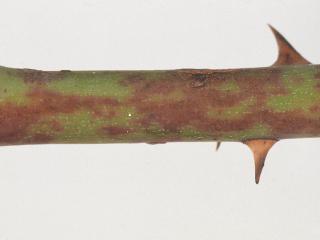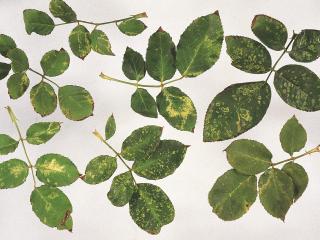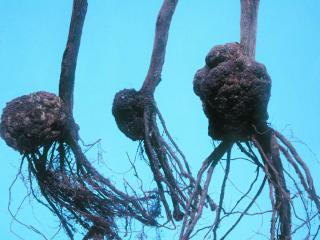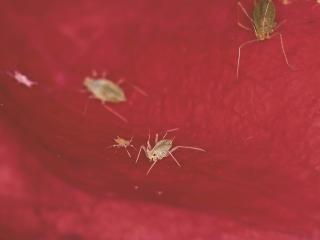Reducing problems
When buying new stock from reputable growers, ask them to recommend cultivars that are more resistant to certain diseases and physiological problems.
Roses need at least six hours of sunshine each day and should be sited in a bed away from invasive tree roots. Roses are heavy feeders and must be planted into soil improved massively with soil improver or compost. Soils must be free draining and sandy soils should have a clay additive worked into the top 30cm of soil. Feed regularly with a complete fertiliser once established.
Humidity encourages fungal disease, as does poor air circulation. Do not position roses too closely together, avoid overhead watering, and prune to maintain an open structure.
Fortunately, in most parts of Western Australia the climate is generally dry, resulting in good conditions for growing roses.
Herbicide overspray
Roses are particularly susceptible to drift from glyphosate, so care is needed when tackling nearby weeds. The safest method is to paint the herbicide onto the weeds with a brush, rather than use a spray which can easily drift. Glyphosate damage results in bleached, distorted foliage that is almost white. Plants will grow out of it in time.
Physiological problems
Physiological problems are often related to climatic conditions. Bull-heads are short, squat blooms triggered by low temperatures. Sometimes, leafy calyces develop, or leaves are seen emerging from the centre of a bloom
This is also climate related. Some rose varieties are more prone to physiological problems.
Fungal problems
Black spot
Black spot, one of the most common diseases of roses, is caused by the fungus Diplocarpon rosae.
Infection results in irregular black spots with fringed margins developing on leaves and young stems. Affected leaves turn yellow and drop prematurely and if defoliation is severe stem dieback can occur. Spores are spread by wind and water-splash.
To control black spot remove and destroy all diseased material. When new growth occurs spray bushes with mancozeb, myclobutanil or triforine. Organic controls include sprays containing bicarbonate of soda (potassium bicarbonate).
Powdery mildew
The fungus Sphaerotheca pannosa causes the disease powdery mildew on roses. New growth is most susceptible. Leaves, stems, and flower buds develop a pale grey powdery coating, leaf edges may scorch and curl inwards, and buds may be deformed. The fungus can overwinter in infected buds. The disease spreads by wind-borne spores.
To control powdery mildew, remove and destroy diseased material. During the growing season spray bushes with mancozeb, lime sulphur, tebuconazole, myclobutanil or triforine. Organic sprays contain bicarbonate of soda (potassium bicarbonate). Make your own spray by mixing one part full cream milk with ten parts water and spray at the first sign of the disease.
Botrytis
The fungus Botrytis cinerea affects most above ground plant parts. Flowers often become spotted or may fail to open, eventually becoming covered in a grey or brown mould. Purple lesions occurring on canes are often caused by botrytis. Spores are wind-borne and also can be spread on garden tools like secateurs.
To treat botrytis remove and destroy diseased material. Spray bushes in late summer and autumn with mancozeb. When pruning, disinfect secateurs in bleach before progressing to the next bush, and apply fungicide immediately to protect wounds from infection.
Downy mildew
The fungus Peronospora sparsa causes downy mildew. Purplish-red or dark brown, irregular, and often angular, blotches develop on leaf surfaces, and during humid weather a blue-grey, downy growth of fungus may appear on the undersides.
The leaves droop, turn yellow, and may drop. Stems and calyces develop purple or blackish spots, streaks, or blotches. Petals have brown, dead areas. Infected buds may produce deformed flowers. Spores are wind-borne but need free water on the leaf surface to germinate.
To control downy mildew remove and destroy diseased material and spray bushes with a copper fungicide.
Rust
Most rusts are host-specific. The fungus Phragmidium mucronatum that causes rust on roses does not infect any other plants.
In spring and early summer, orange powdery pustules develop on the undersides of leaves. Upper leaf surfaces become speckled yellow. These leaves drop prematurely. In late summer, black or brown spore masses appear with the orange pustules — these are the teliospores that can overwinter. The fungus spreads rapidly and can cause severe defoliation. The spores are spread by wind.
To control rose rust remove and destroy diseased material. When new growth occurs, spray bushes with, mancozeb, myclobutanil or triforine. An organic spray for rust is lime sulphur or bicarbonate of soda.
Anthracnose
The fungus Sphaceloma rosarum causes anthracnose, which is sometimes confused with black spot on rose leaves. The differences are that anthracnose spots are smaller and initially have sharply defined margins. As the spots enlarge, the centres become ash grey and drop away, leaving the black margins intact. The leaves become red or yellow, and may drop prematurely, but not to the same degree as with black spot.
To control anthracnose, remove and destroy diseased material. Spray bushes with mancozeb or triforine.
Cane canker
Apart from Botrytis, two of the commonest fungi to cause cane canker are Coniothyrium and Botryosphaeria species. These diseases are more commonly seen on plants stressed through poor management practices such as inadequate nutrition or irrigation.
Water-borne spores enter mainly through pruning wounds or other injuries. The disease can affect any part of the stem, initially producing yellow or red spots on the bark. These enlarge into brown cankers with dark margins, and the bark cracks and becomes sunken. Tiny black fruiting structures are sometimes seen. Canker can encircle the stem or travel down it, killing the plant.
To treat canker, prune stems back to healthy buds and destroy diseased material. After pruning apply mancozeb to protect wounds from infection.
Other rose problems
Phytophthora and Pythium root rots
Roses affected by root rots wilt and may eventually die. The root ball may be water-soaked and brown and none or few new white roots may be seen. Phytophthora root rot may be caused by more than one species of the pathogen. Common sources of Phytophthora cinnamomi (jarrah dieback) are infected soil or irrigation water that has been in contact with the soil, for example, dam water. Other species of Phytophthora may be imported in potting mixes.
There is no cure for infected plants, but the disease may be suppressed with the use of phosphorous acid.
Pythium affects plants in a similar manner but is more often a sign that the plants are being stressed in some other way, for example, by high salinity, low pH, or waterlogging.
Nematodes
Nematodes of the genus Meloidogyne attack the roots of a wide range of plants including roses. The damaged root system develops root knots which causes low growth, wilting, and yellowing leaves. Nematodes are spread by introducing infested plants or soil to your garden, and also can be carried on garden tools.
To reduce nematode numbers improve the soil with organic matter and plant a crop of marigolds. Roses grafted onto fortuniana rootstock are resistant to nematodes.
Rose mosaic virus
A complex of viruses causes mosaic, which can appear on leaves in a number of different formats — for example, narrow yellow bands along the veins, yellow mottling which spreads and merges, or broad bands of pale green or creamy white tissue. Sometimes the plant’s vigour is reduced, but generally mosaic is not a serious problem. There is no remedy.
Crown gall
The bacterium Agrobacterium tumefaciens causes crown gall. The galls that develop on stems or just under the soil surface are round and rough textured. Young galls are soft and white or pale green — older ones are dark and woody. Affected plants lose vigour and may become stunted, with poor leaves and fewer flowers. The bacterium is spread on garden tools.
Treat the soil with products containing beneficial bacteria Agrobacterium radiobacter, strain K1026. This works best as a preventative and is not a cure.
Leaf-cutter bees
Female leaf-cutter bees (Megachile spp) cut semi-circular holes in leaves and use the segments to line their nests. The damage is minimal and harmless. No control is necessary.
Insect pests
Aphids
Aphids are sap-sucking insects that extract nutrients from the plant, particularly in spring. This activity can result in distorted leaves, drooping buds, stunted growth, and poor flowers. Aphids secrete honeydew, on which sooty mould may develop, further spoiling the plant’s appearance.
Small populations can be removed by hosing at high pressure, but this needs to be repeated every two or three days. If gardeners can wait two weeks without spraying any chemicals, beneficial insects like ladybirds and lacewings will build to sufficient numbers to prey on the aphids and reduce numbers. Spray big infestations with imidacloprid, acetamiprid, maldison, pyrethrins, or white oil. Chilli and/or garlic sprays are also effective and the garlic acts as a repellent to further aphid attack. This treatment will need to be repeated.
Thrips
Thrips are sap-sucking insects that can cause deformities in flowers, leaves, stems, and shoots. The insects are difficult to see because they are small and hide deep in the flower or on the undersides of the leaves, which become silvery on the upper surface. Thrips are most active during spring, summer and autumn.
To check for infestations tap flowers over a sheet of white paper and examine the black, torpedo-shaped 'specks' beneath a magnifying glass.
Small populations may not do enough damage to warrant chemical control. For large infestations, which can seriously weaken the plant, spray with imidacloprid, acetamiprid or pyrethrins. Horticultural soap is an organic control but it is often difficult to kill the pests when they are hidden deep within the flower petals.
Two-spotted mites
Mites are sap-sucking arachnids that can cause yellowing or bronzing of leaves. If the population is large, leaf drop occurs and the health of the plant is reduced. Two-spotted mite, also known as red spider mite, is the most serious pest mite. Although mites are so tiny that they are difficult to see, the fine webbing that they build across leaves and between leaves and stems betrays their presence. To reduce their numbers spray water beneath the rose leaves.
Being arachnids, mites are not susceptible to insecticides. Spray with lime sulphur or horticultural soap.
Scale insects
Scale are sap-sucking insects with a waxy or armoured cover which they use to protect themselves. Scales found on roses include cottony-cushion scale, red scale and rose scale and include ‘soft’ and ‘armoured’ varieties.
In soft scales, some scale insects hatch from eggs, while others are born live. Juvenile scales are known as crawlers. They disperse to favourable sites, settle down and start feeding. The juveniles then become sedentary, and start building their protective scale covers.
The females of most species remain under the covers for their entire life, while the male insects live under the covers until maturity, when they emerge as winged adults.
Scale is usually found on canes at the base of the plant but can cover higher stems. For minor infestations the scale insects can be rubbed off the rose canes using a damp cloth. Alternately smother the scale by spraying with a horticultural oil or spray with a potassium soap which works by blocking the breathing pores and disolving the scale's outer covering so it dehydrates and dies.

